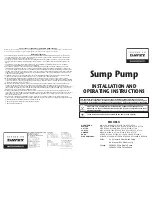
Page 15
10HP OPERATING SEQUENCE
A–10HP Operation Sequence
This is the sequence of operation for 10HP units. The sequence is
outlined by numbered steps which correspond to circled numbers
on the adjacent diagram.
NOTE– The thermostat used may be electromechanical or electron-
ic.
NOTE– Transformer in indoor unit supplies power (24 VAC) to the
thermostat and outdoor unit controls.
COOLING:
1 – Cooling demand initiates at Y1 in the thermostat. Internal thermostat
wiring energizes terminal O energizing the reversing valve L1.
2 – Compressor contactor K1 is energized.
3 – K1-1 N.O. closes energizing compressor (B1) and outdoor fan motor
(B1). Compressor (B1) and outdoor fan motor (B4) begin immediate
operation.
END OF COOLING DEMAND:
4 – Cooling demand is satisfied. Terminal Y1 is de-energized.
5 – Terminal O and reversing valve L1 are de-energized
6 – Compressor contactor K1 is de-energized.
7 – K1-1 opens and compressor (B1) and outdoor fan motor (B4)
are de-energized and stop immediately.
FIRST STAGE HEAT:
8 – Heating demand initiates at W1 in the thermostat. Compressor
contactor K1 is energized.
9 – K1-1 N.O. closes energizing compressor and outdoor fan mo-
tor. Compressor (B1) and outdoor fan motor (B4) begin im-
mediate operation.
END OF FIRST STAGE HEAT:
10 – Heating demand is satisfied. Terminal W1 is de-energized.
11 – Compressor contactor K1 is de-energized.
12 – K1-1 opens and compressor (B1) and outdoor fan motor (B4) are de-
energized and stop immediately.
AUXILIARY HEAT (SECOND STAGE):
13 – Additional heating demand initites at W3 in the thermostat. Outdoor
unit remains running. W1 of indoor unit terminal strip TB1 is energized
initiating first stage heat from indoor unit.
14 – If outdoor temperature is below the balance point, N.O. low ambient
cut in thermostat S23 will close.
15 – When S23 is closed, W2 of indoor unit terminal strip TB1 is energized
initiating second stage heat from indoor unit.
END OF AUXILIARY HEAT (SECOND STAGE):
16 – Heating demand is satisfied. Terminal W3 is de-energized. Indoor unit
heating operation stops and outdoor unit continues operation.
EMERGENCY HEAT:
17 – Emergency heat mode is set at the thermostat. Outdoor unit will not
be operational in this mode. Terminal E2 is energized in the thermo-
stat. Emergency heat relay K26 is energized.
18 – N.O. K26-1 closes energizing W1 and W2 on terminal strip TB1 of in-
door unit. Indoor unit operates in second stage heat mode.
DEFROST MODE:
19 – During heating operation when outdoor coil temperature drops be-
low 35
_
+ 4
_
F Defrost Switch (thermostat) S6 closes.
20 – Defrost control CMC1 begins timing. If defrost thermostat (S6) re-
mains closed at the end of the 30,60 or 90 minute period, defrost relay
K4 energizes and defrost begins.
21 – N.O. K4-3 closes energizing the reversing valve.
22 – N.O. K4-1 closes energizing W1 on TB1 terminal strip of indoor unit.
Indoor unit operates in the first stage heat mode.
23 – N.C. K4-2 opens and outdoor fan motor B4 stops.
24 – Defrost continues 14 + 1 minutes or until thermostat switch (S6)
opens. When defrost thermostat opens defrost control CMC1 loses
power and resets.
25 – Defrost relay K4 is de-energized.
26 – K4-1 opens and W1 on terminal strip TB1 of indoor unit is de-ener-
gized.
27 – K4-2 closes and the outdoor fan begins operation.
28 – K4-3 opens de-energizing the reversing valve.
VI – WIRING DIAGRAM AND SEQUENCE OF OPERATION
1
2
3
4
5
6
7
8
9
10
11
12
13
14
15
16
17
18
19
20
21
22
23
24
25
26
27
28


































